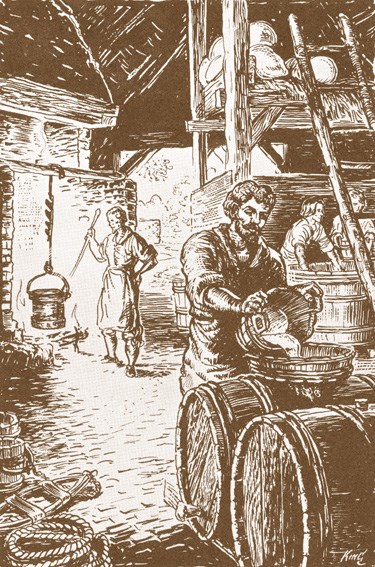
NPS artist Sydney King Oh we can make liquor to sweeten our lips - New England rhyme
Beer, the result of the slow fermentation of malted and hopped liquid, is divided into three basic categories. Stout is a dark, heavy beverage with a relatively high alcoholic content. Lager, produced by a yeast which is activated at a relatively low temperature (40° F), is the lightest form of beer. In between these two extremes in both color and alcohol content is ale, which is produced by yeast which ferments best at about 60° F. Ale, because it was produced at a temperature which was more easily maintained, was the brew of choice in colonial times. Producing a drinkable ale was not easy, and the colonists were not always successful, as the complaint from a 17th century inhabitant of Jamestown confirms: "I would you could hang that villain Duppe who by his stinking beer hath poisoned . . . the colony." Unlike the sophisticated scientific methods employed in today's breweries, the beer-maker of the 17th century relied on taste, smell and touch. In England, one of a housewife's duties was the production of beer for her family and servants. Beer, from the Middle Ages well into the 17th century, was produced commercially by both men and women. Many ingredients were added during the brewing process. The first step in making beer was choosing water of a pleasing taste. Fortunately for the consumer, all the boiling which took place in subsequent steps would destroy any dangerous bacteria. The grain, which gave the beverage its body (barley was the usual ingredient, although corn, oats, wheat and rye could also be used) had to be malted (sprouted then dried in kilns) before being added to the mixture. Sugar of some type, usually in the form of molasses or honey, provided nourishment to the yeast. Hops, the fruit of a vinelike plant related to the mulberry tree, gave the ale its characteristic scent and flavor. To make beer, malt was soaked in a large wooden mash tub at low temperatures then separated out of the liquid and ordinarily used for animal food. The liquid, called "wort," was transferred to the keeler, a large copper pot to which was added hops and other ingredients. After boiling the mixture for several hours, the brewer cooled it to about 70° F and sprinkled on the yeast, which began to digest the sugar in the solution and excrete it as alcohol. Bacteria and foreign yeast could spoil a brew, so it was important to keep the keeler covered. Stirring took place periodically, traditionally done with a bunch of broomstraw which was impregnated with yeast and quickened the action. When fermentation was complete, the beverage would be either consumed right away or transferred to barrels for storage, leaving as much as the sediment behind in the keeler as possible. BIBLIOGRAPHY: Bonnett, Kendra. A Report on Drinking and Beer Brewing in the Seventeenth Century. Clark, Alice. Working Life of Women in the Seventeenth Century. Hartley, Dorothy. Lost Country Life. |
Last updated: February 26, 2015
